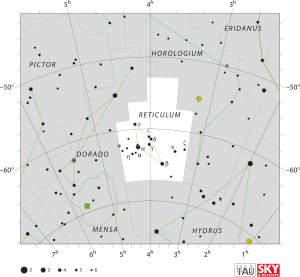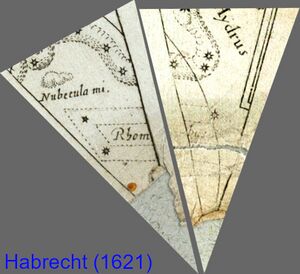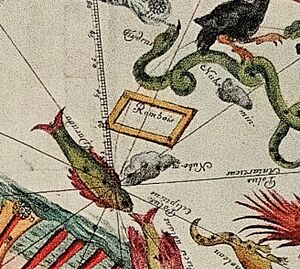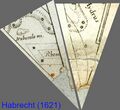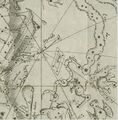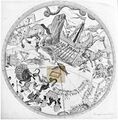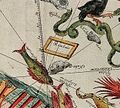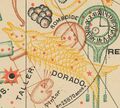Reticulum: Difference between revisions
(image of Habrecht's map added.) |
IanRidpath (talk | contribs) m (→IAU WGSN: Cap A for Alpha) |
||
| (23 intermediate revisions by 3 users not shown) | |||
| Line 1: | Line 1: | ||
[[File:Reticulum IAU.svg|alt=star chart|thumb|IAU star chart "Reticulum", IAU and Sky & Telescope magazine (Roger Sinnott & Rick Fienberg)]] |
[[File:Reticulum IAU.svg|alt=star chart|thumb|IAU star chart "Reticulum", IAU and Sky & Telescope magazine (Roger Sinnott & Rick Fienberg)]] |
||
One of the [[:Category:88_IAU-Constellations|88 IAU constellations]]. In its modern shape, |
One of the [[:Category:88_IAU-Constellations|88 IAU constellations]]. In its modern shape, Reticulum was invented by the French scholar Nicolas Louis de Lacaille during his stay at the Cape of Good Hope in 1751–52.<ref>Ian Ridpath, Star Tales, [http://www.ianridpath.com/startales/reticulum.html Online Edition], second entry in [http://www.ianridpath.com/startales/reticulumlacaille.html Online Edition]</ref> It was published with his report in 1756 and named it in French ''Réticule Rhomboïde'' because he actually transformed an earlier constellation (Rhombus) invented by his compatriot Isaac Habrecht. |
||
==Etymology and History== |
==Etymology and History== |
||
[[File:Rhombus Habrecht1621.jpg|alt=globe gores arranged to read "rhombus" |thumb|"Rhombus" on Habrecht Globe gores (1621), CC BY WGSN]] |
|||
| ⚫ | [[File:Rhombus Habrecht.JPG|alt=star chart (Habrecht)|thumb|Habrecht (1666) star chart with [https://echo.mpiwg-berlin.mpg.de/ECHOdocuView?url=/mpiwg/online/permanent/library/27CWZ8E0&start=351&viewMode=images&pn=359&ww=0.25&wh=0.2654&wx=0.4382&wy=0.305 " |
||
| ⚫ | '''Isaac Habrecht''' (1589–1633) was a professor of astronomy and mathematics in Strasbourg (his father and a nephew were clockmakers). He made a celestial planisphere and a celestial globe (1628) for which he vastly used the newly invented Dutch constellations. However, at the area of Reticulum, there was no constellation yet and Habrecht invented a new one by forming a geometrical figure of a quadrilateral named "''' |
||
| ⚫ | |||
| ⚫ | The |
||
| ⚫ | [[File:Rhombus Habrecht.JPG|alt=star chart (Habrecht)|thumb|Habrecht (1666) star chart with [https://echo.mpiwg-berlin.mpg.de/ECHOdocuView?url=/mpiwg/online/permanent/library/27CWZ8E0&start=351&viewMode=images&pn=359&ww=0.25&wh=0.2654&wx=0.4382&wy=0.305 "Rhomb<sub>9</sub>" (Rhombus)] as a new constellation (CC0).]] |
||
| ⚫ | '''Isaac Habrecht''' (1589–1633) was a professor of astronomy and mathematics in Strasbourg (his father and a nephew were clockmakers). He made a celestial planisphere (1666) and a celestial globe (1628) for which he vastly used the newly invented Dutch constellations. However, at the area of Reticulum, there was no constellation yet and Habrecht invented a new one by forming a geometrical figure of a quadrilateral named "'''Rhomb<sub>9</sub>'''" on the planisphere. Subscript "9" comes from Mediaeval [https://archive.org/details/CappelliDizionarioDiAbbreviature/page/n21/mode/1up?view=theater palaeography] and was reused in Early Modern Time to indicate the Latin ending "-us". Normally, it is written as superscript, but Habrecht makes a subscript. Cross-checking the Habrecht-''globe'' (1628) it becomes obvious that Habrecht meant "Rhombus". |
||
| ⚫ | The Latin term "rhombus" derives from Ancient Greek ῥόμβος (rhómbos) and describes an equilateral quadrilateral, i.e. a quadrilateral with four edges of the same length. It is not exactly known which stars Habrecht had in mind, but his figure is drawn between the new Dutch constellations "[[Dorado]]" and "[[Hydrus]]". |
||
| ⚫ | |||
[[File:Royer rhombus detail.jpg|alt=map detail|thumb|Rhombus in Royer (1679), CC0]] |
|||
| ⚫ | |||
=== Lacaille's transformations === |
|||
'''Nicolas Louis de Lacaille''' apparently knew and transformed this constellation. In his first publication<ref>Nicolas Louis de Lacaille (1752). Mémoire: Tables des Ascension Droites et des Declinations Apparentes des étoiles australes renfermées dans le tropique du Capricorne; observées au cap de Bonne-espérance, dans l'intervalle du 6 Août 1751, au 18 Juillet 1752. par M. l'Abbé de la Caille. (p. 539-587) |
'''Nicolas Louis de Lacaille''' apparently knew and transformed this constellation. In his first publication<ref>Nicolas Louis de Lacaille (1752). Mémoire: Tables des Ascension Droites et des Declinations Apparentes des étoiles australes renfermées dans le tropique du Capricorne; observées au cap de Bonne-espérance, dans l'intervalle du 6 Août 1751, au 18 Juillet 1752. par M. l'Abbé de la Caille. (p. 539-587) |
||
Remarques sur le Catalogue précédent. (p. 587-592). Histoire de l'Académie Royale, Janvier 1752. </ref> [https://gallica.bnf.fr/ark:/12148/bpt6k35505/f786.image (Mémoire) in 1752 for the Académie Royale de France] he wrote in French: <blockquote>Le '''Réticule rhomboïde''', petit instrument astronomique qui a servi á desser ce catalogue: on le construit par l'intersection de quatre droites tirées de chaque angle d'un carré au millieu de deux côtés oppossés (p. 588). </blockquote>English: <blockquote>The Rhomboid Reticle, a small astronomical instrument used to draw up this catalogue: it is constructed by the intersection of four straight lines drawn from each corner of a square at the midpoint of two opposite sides. </blockquote> |
Remarques sur le Catalogue précédent. (p. 587-592). Histoire de l'Académie Royale, Janvier 1752. [https://gallica.bnf.fr/ark:/12148/bpt6k35505/f786.item Gallica] </ref> [https://gallica.bnf.fr/ark:/12148/bpt6k35505/f786.image (Mémoire) in 1752 for the Académie Royale de France] he wrote in French: <blockquote>[[File:Lacaille-ret.jpg|alt=historical map (detail)|thumb|Lacaille (1752): [https://gallica.bnf.fr/ark:/12148/bpt6k35505/f789.item Le Reticule Romboide]. ]]Le '''Réticule rhomboïde''', petit instrument astronomique qui a servi á desser ce catalogue: on le construit par l'intersection de quatre droites tirées de chaque angle d'un carré au millieu de deux côtés oppossés (p. 588). </blockquote>English: <blockquote>The Rhomboid Reticle, a small astronomical instrument used to draw up this catalogue: it is constructed by the intersection of four straight lines drawn from each corner of a square at the midpoint of two opposite sides. </blockquote> |
||
[[File:Lacaille1756 starChart hi.JPG|alt=historical map (detail)|thumb|Lacaille's constellation Reticulum in its [https://www.e-rara.ch/zut/content/zoom/197200?lang=en&zoom=5&lat=1145&lon=3274&layers=B first publication] (labelled Reticulus). ]] |
|||
Since he explicitly says ‘square’ and not ‘rectangle’ in general, this instrument is probably a small rhombus. In his Latin map and star catalogue, [https://www.e-rara.ch/zut/content/pageview/152610 Coelum australe stelliferum] (1756, republished 1763), Lacaille labels the constellation only "'''Reticulus'''" (without any reference to the rhombe). Next to the accompanying text which describes the measurements and observations, he presents several drawings to explain the construction of four ''reticuli''. <blockquote>[[File:Lacaille descriptionLatin.JPG|alt=screenshot of text|thumb|Lacaille (1763) description of the "[https://www.e-rara.ch/zut/content/pageview/152608 small instrument]" and its construction in Latin. ]]'''Lacaille's French:''' Ces observations ont été faites avaec une Pendule réglée aux révolutions des Etoiles, et avav une lunette garnie de différents réticules. |
|||
[...] |
[...] |
||
| Line 20: | Line 27: | ||
[...] |
[...] |
||
The second reticle, which we have called the small reticle, was constructed in this way. Having described on a copper plate a square A B C D, each side of which was 15,548 lines long, the sides A B, C D were divided into four equal parts A E, E F, F G, G B and C K, K I, I H, H D; the straight lines E I, G I, F H, F K were connected, forming the rhomb F M I L which is the true field of the reticule. Then almost everything enclosed in the circle N I O F inferior to the square A C was hollowed out with a file, leaving only the blades F L, L I, I M, and the trapezoidal space A N M F. Finally, livers were made in the lines F I, N O, and the reticule was completed. </blockquote> |
The second reticle, which we have called the small reticle, was constructed in this way. Having described on a copper plate a square A B C D, each side of which was 15,548 lines long, the sides A B, C D were divided into four equal parts A E, E F, F G, G B and C K, K I, I H, H D; the straight lines E I, G I, F H, F K were connected, forming the rhomb F M I L which is the true field of the reticule. Then almost everything enclosed in the circle N I O F inferior to the square A C was hollowed out with a file, leaving only the blades F L, L I, I M, and the trapezoidal space A N M F. Finally, livers were made in the lines F I, N O, and the reticule was completed. </blockquote> |
||
[[File:Lacaille descriptionLatin 3rdNet.jpg|thumb|Lacaille's Latin description of the 3rd net (1756), CC0, [https://www.e-rara.ch/zut/content/pageview/152610 rara].]] |
|||
This reticle with a central rhomb seems to be meant with the constellation. Lacaille describes it for the second of his "nets" in detail and then refers the third and fourth net to a similar principle. However, the drawing for the third net looks differently. |
|||
| ⚫ | |||
===Transfer and Transformation of the Constellation=== |
===Transfer and Transformation of the Constellation=== |
||
<gallery> |
|||
File:Rhombus Habrecht1621.jpg|"Rhombus" on Habrecht Globe gores (1621), CC BY WGSN |
|||
File:Rhombus Habrecht.JPG|Habrecht (1666) star chart with "[https://echo.mpiwg-berlin.mpg.de/ECHOdocuView?url=/mpiwg/online/permanent/library/27CWZ8E0&start=351&viewMode=images&pn=359&ww=0.25&wh=0.2654&wx=0.4382&wy=0.305 Rhomb<sub>9</sub>" (Rhombus]) as a new constellation (CC0). |
|||
File:Royer rhombus.jpg|Royer (1679) southern sky, constellation "Rombois" (Rhombus) highlighted, (CC BY "IAU WGSN") |
|||
File:Royer rhombus detail.jpg|Rhombus in Royer (1679), CC0 |
|||
File:Lacaille-ret.jpg|Lacaille's invention of "Le Reticule Romboide" in 1752. |
|||
File:Lacaille1756 starChart hi.JPG|Lacaille's "Reticulus", published in 1756/1763. |
|||
File:Simon1894 Dorado+Ret.jpg|Reticulum behind Dorado at ''Planisferio celeste'' (Carlos Simón 1894) |
|||
</gallery> |
|||
| ⚫ | |||
While Lacailles clearly describes how to draw a "rhombic net" on a slider in the focal point of his telescope (copper plates), contemporary star lore of the 20th century mixes this description with modern crosshairs and scales in eyepieces. |
|||
Lacaille describes an extra box (in front of his eyepiece) at the focal point of tube which is equipped with a slider to carry the "reticule". He describes four of these "nets". The first net ("Le premier de ces réticules") is composed by 1,684 lines and that he measures the time intervals of transitting stars, the second (petit réticule) and the third (grand réticule) have a little rhombus in the middle. The fourth (moyen réticule) is described similar to the third one; they seem to be divided in an upper and lower part to be used alternately while observing stars in transit. |
|||
== IAU WGSN == |
|||
As the original name of the constellation might be considered "Rhombe" and this rhombus-structure was definitely included in the original naming of Reticulus, it was suggested in 2023 to name the brightest star of the modern constellation "Rhombe" or "Rhombo" or "Rhombus". As the earliest occurance of the name on the globe by Habrecht (1621) uses the term "Rhombus", WGSN decided in 2024 to use this Greco-Latin term for the brightest star in Reticulum. |
|||
α Ret (Alpha Reticuli) is a G-type red giant star at distance ~50 parsecs with Vmag of 3.36 ([https://simbad.cds.unistra.fr/simbad/sim-id?Ident=alf+Ret&NbIdent=1&Radius=2&Radius.unit=arcmin&submit=submit+id SIMBAD]). |
|||
| ⚫ | |||
==Weblinks== |
==Weblinks== |
||
| Line 41: | Line 65: | ||
[[Category:Eurasia]] |
[[Category:Eurasia]] |
||
[[Category:Constellation]] |
[[Category:Constellation]] |
||
[[Category: |
[[Category:European]] |
||
[[Category:Mesopotamian]] |
|||
[[Category:West Asian]] |
|||
[[Category:Modern]] |
[[Category:Modern]] |
||
[[Category:88 IAU-Constellations]] |
[[Category:88 IAU-Constellations]] |
||
Latest revision as of 11:33, 25 September 2024
One of the 88 IAU constellations. In its modern shape, Reticulum was invented by the French scholar Nicolas Louis de Lacaille during his stay at the Cape of Good Hope in 1751–52.[1] It was published with his report in 1756 and named it in French Réticule Rhomboïde because he actually transformed an earlier constellation (Rhombus) invented by his compatriot Isaac Habrecht.
Etymology and History
Origin of Constellation
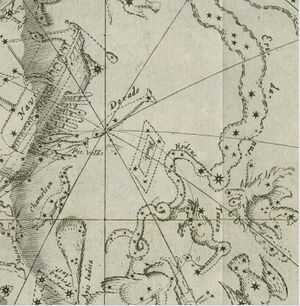
Isaac Habrecht (1589–1633) was a professor of astronomy and mathematics in Strasbourg (his father and a nephew were clockmakers). He made a celestial planisphere (1666) and a celestial globe (1628) for which he vastly used the newly invented Dutch constellations. However, at the area of Reticulum, there was no constellation yet and Habrecht invented a new one by forming a geometrical figure of a quadrilateral named "Rhomb9" on the planisphere. Subscript "9" comes from Mediaeval palaeography and was reused in Early Modern Time to indicate the Latin ending "-us". Normally, it is written as superscript, but Habrecht makes a subscript. Cross-checking the Habrecht-globe (1628) it becomes obvious that Habrecht meant "Rhombus".
The Latin term "rhombus" derives from Ancient Greek ῥόμβος (rhómbos) and describes an equilateral quadrilateral, i.e. a quadrilateral with four edges of the same length. It is not exactly known which stars Habrecht had in mind, but his figure is drawn between the new Dutch constellations "Dorado" and "Hydrus".
Augustin Royer included this constellation in his star chart (1679), labelling it "Rombois".
Lacaille's transformations
Nicolas Louis de Lacaille apparently knew and transformed this constellation. In his first publication[2] (Mémoire) in 1752 for the Académie Royale de France he wrote in French:
 Lacaille (1752): Le Reticule Romboide.
Lacaille (1752): Le Reticule Romboide.Le Réticule rhomboïde, petit instrument astronomique qui a servi á desser ce catalogue: on le construit par l'intersection de quatre droites tirées de chaque angle d'un carré au millieu de deux côtés oppossés (p. 588).
English:
The Rhomboid Reticle, a small astronomical instrument used to draw up this catalogue: it is constructed by the intersection of four straight lines drawn from each corner of a square at the midpoint of two opposite sides.
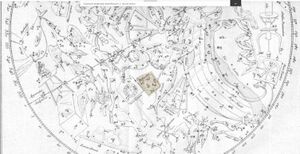
Since he explicitly says ‘square’ and not ‘rectangle’ in general, this instrument is probably a small rhombus. In his Latin map and star catalogue, Coelum australe stelliferum (1756, republished 1763), Lacaille labels the constellation only "Reticulus" (without any reference to the rhombe). Next to the accompanying text which describes the measurements and observations, he presents several drawings to explain the construction of four reticuli.
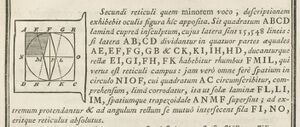 Lacaille (1763) description of the "small instrument" and its construction in Latin.
Lacaille (1763) description of the "small instrument" and its construction in Latin.Lacaille's French: Ces observations ont été faites avaec une Pendule réglée aux révolutions des Etoiles, et avav une lunette garnie de différents réticules.
[...]
Le second réticule que nous avons appellé le petit réticule étoit construit de cette manier. Ayant décrit sur une plaque de cuivre un quarré A B C D, dont chaque côté étoit de 15,548 lignes de longueur , on a divisé les côtés A B, C D en quatre parties égales A E, E F, F G, G B et C K, K I, I H, H D; on a tié les droites E I, G I, F H, F K, ce qui a formé le rhombe F M I L qui est le vrai champ du réticule. Ensuite on a évidé à la lime presque tout ce qui étoit renfermé dans le cercle N I O F inferit au quarré A C ; on n'a laissé que lames F L, L I, I M, et l'espace trapézoïde A N M F. Enfin on a rendu des foies dans les lignes F I, N O, et le réticules étoit achevé.
English: These observations were made with a Pendulum set to the revolutions of the Stars, and with a telescope fitted with different reticles.
[...]
The second reticle, which we have called the small reticle, was constructed in this way. Having described on a copper plate a square A B C D, each side of which was 15,548 lines long, the sides A B, C D were divided into four equal parts A E, E F, F G, G B and C K, K I, I H, H D; the straight lines E I, G I, F H, F K were connected, forming the rhomb F M I L which is the true field of the reticule. Then almost everything enclosed in the circle N I O F inferior to the square A C was hollowed out with a file, leaving only the blades F L, L I, I M, and the trapezoidal space A N M F. Finally, livers were made in the lines F I, N O, and the reticule was completed.
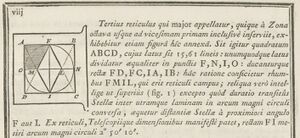
This reticle with a central rhomb seems to be meant with the constellation. Lacaille describes it for the second of his "nets" in detail and then refers the third and fourth net to a similar principle. However, the drawing for the third net looks differently.
Transfer and Transformation of the Constellation
Habrecht (1666) star chart with "Rhomb9" (Rhombus) as a new constellation (CC0).
Mythology
While Lacailles clearly describes how to draw a "rhombic net" on a slider in the focal point of his telescope (copper plates), contemporary star lore of the 20th century mixes this description with modern crosshairs and scales in eyepieces.
Lacaille describes an extra box (in front of his eyepiece) at the focal point of tube which is equipped with a slider to carry the "reticule". He describes four of these "nets". The first net ("Le premier de ces réticules") is composed by 1,684 lines and that he measures the time intervals of transitting stars, the second (petit réticule) and the third (grand réticule) have a little rhombus in the middle. The fourth (moyen réticule) is described similar to the third one; they seem to be divided in an upper and lower part to be used alternately while observing stars in transit.
IAU WGSN
As the original name of the constellation might be considered "Rhombe" and this rhombus-structure was definitely included in the original naming of Reticulus, it was suggested in 2023 to name the brightest star of the modern constellation "Rhombe" or "Rhombo" or "Rhombus". As the earliest occurance of the name on the globe by Habrecht (1621) uses the term "Rhombus", WGSN decided in 2024 to use this Greco-Latin term for the brightest star in Reticulum.
α Ret (Alpha Reticuli) is a G-type red giant star at distance ~50 parsecs with Vmag of 3.36 (SIMBAD).
Weblinks
References
- ↑ Ian Ridpath, Star Tales, Online Edition, second entry in Online Edition
- ↑ Nicolas Louis de Lacaille (1752). Mémoire: Tables des Ascension Droites et des Declinations Apparentes des étoiles australes renfermées dans le tropique du Capricorne; observées au cap de Bonne-espérance, dans l'intervalle du 6 Août 1751, au 18 Juillet 1752. par M. l'Abbé de la Caille. (p. 539-587) Remarques sur le Catalogue précédent. (p. 587-592). Histoire de l'Académie Royale, Janvier 1752. Gallica
